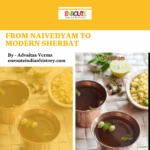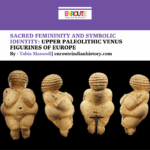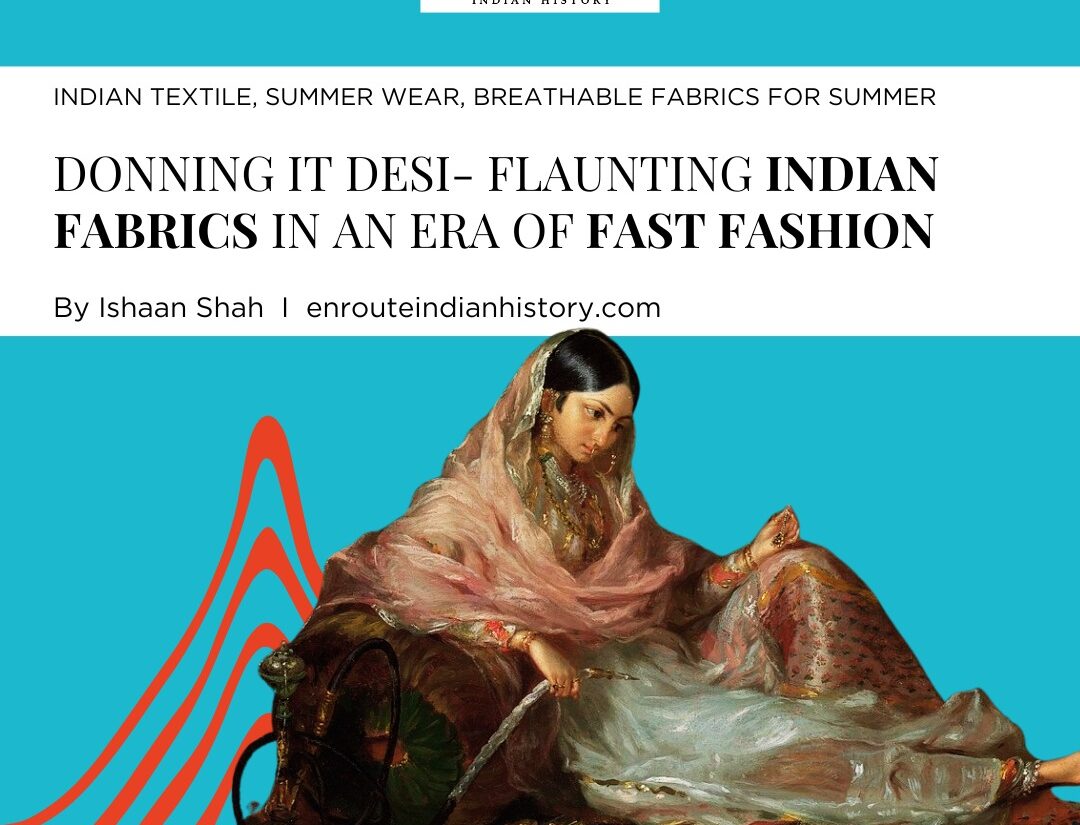
The fashion industry is no different in an increasingly globalized world where every action has a global repercussion. Exacerbated by the fast fashion trend, this industry leads to environmental disasters like any other commercial industry. It’s in this context that one needs to switch to sustainable Indian fashion that includes indigenous textiles, which uses sustainable materials, thereby increasing longevity and breathability, especially during summer.
Fast fashion is an exploitative business model wherein clothes are mass-produced and are deliberately designed to have a limited lifespan as designs change frequently and are cheap to produce. This model often has a high consumption rate and results from emulating new fashion trends, where customers seek to update their fashion styles now and then. This model prioritizes production speed and adapting to new trends and styles. But, sustainability seems to lose its way through this mania of fast fashion. The rapidity of the production of these low-cost, low-longevity clothes leads to the generation of a lot of waste and the depletion of natural resources. This is attributed to the fact that when these clothes are produced, the longevity factor is not considered, and even though the customers want to use them for a longer duration, the clothes are produced in such a way that they wear out quickly. This in turn leads to the rapid disposal of clothes that end up in landfills, exacerbating environmental harm. That’s not all. Of all the wastewater globally, 20 % of it is attributed to textile dyeing, which is toxic and is a major concern for water pollution. Moreover, fashion contributes to more than 10 % of carbon emissions globally. Even though this model makes it affordable for consumers to buy clothes at low prices, it encourages a “throwaway” mentality among consumers, wherein the garments are unsustainable and non-biodegradable. In this context of the increasing popularity of fast fashion, it is deemed necessary to switch to sustainable Indian fashion and sustainable summer clothing. These indigenous fabrics are manufactured from natural fibers like cotton, wool, and silk, which are renewable. Since these traditional Indian textiles are handwoven, the weavers use handlooms that don’t require electricity, there by enhancing energy efficiency. These handwoven masterpieces, crafted to perfection by skilled weavers, are airy and breathable, making them ideal summer wear.

(Source- Britannica, Graveyard for Used Clothes in Atacama Desert, Chile)
WHAT DID OUR ANCESTORS WEAR?
Our early ancestors protected themselves from harsh climatic conditions by wearing warm clothes made from animal furs and skins. The clothing might have been decorated with animal teeth as jewelry, pearls, or bones. In the Indian context, the Harappan Civilization suggests weaving and spinning activities with the finds of needles and spindle whorls. The Rigveda mentions two garments, one is vasa, or the lower garment and the other is adhivasa, or the upper garment. The Sangam Age and its literature, mention cotton and silk being spun and woven with women as part-time spinners. The literature also talks about intricate designs on these fabrics. Another ancient source, the Periplus of the Erythraean Sea mentions Uraiyur, which was the capital of the early Cholas, as an important center for the cotton trade. Foreign accounts such as those of Arrian and Megasthenes observe people who wore garments made out of cotton and muslin. Additionally, sculptural evidence comes from Bharhut and Sanchi Stupa, where figures of soldiers and charioteers can be seen wearing a full-sleeve tunic with kamarband and boots. Some bhikkhunis or Buddhist nuns in Bharhut are seen wearing a skirt-like garment. It is crucial to understand the native fabrics of the Indian subcontinent, which sustain longer than machine-made fabrics, and some of them, are ideal for summer wear.
INDIAN TEXTILES AND SUSTAINABILITY
Starting with cotton, the earliest evidence of this fabric comes from the Neolithic site of Mehrgarh, now situated in Pakistan. Several threads that were preserved by mineralization in a copper bead from a burial were analyzed metallurgically. The analysis concluded the fibers as cotton (genus Gossypium). This fabric is breathable owing to its ventilative properties along with being durable. Moreover, this fabric is biodegradable as its fibers degrade almost 95 % more than polyester, a synthetic fiber. The latter becomes quite stagnant and doesn’t deteriorate after some time but by wearing Indian cotton summer dresses, one would contribute to environmental sustainability by reducing micro-plastic pollution. Organic cotton is also gaining ground in India, with the country being one of the leading producers.
Coming to what the Romans described this fabric as “woven air”, muslin is a woven cotton fabric that is smooth, lightweight as well as with high absorbent quality. The history of this fabric dates to the ancient period where the Greek goddesses were adorned in muslin and the product was a highly profitable import item from India. It is commonly believed that muslin originated from the Iraqi city of Mosul but it is clear that it originated from ancient India. Weavers in Dhaka, Bangladesh used to handweave this cloth using a method- discontinuous weft technique. This technique made the weaver work two layers of weft- one was as fine as spider’s silk for holding the cloth together and the other was for forming the pattern. Each motif was worked separately using bamboo sticks to interlace the pattern threads with the warp threads. Muslin is made from natural fibers (100% organic cotton) that are emission-free and biodegradable.
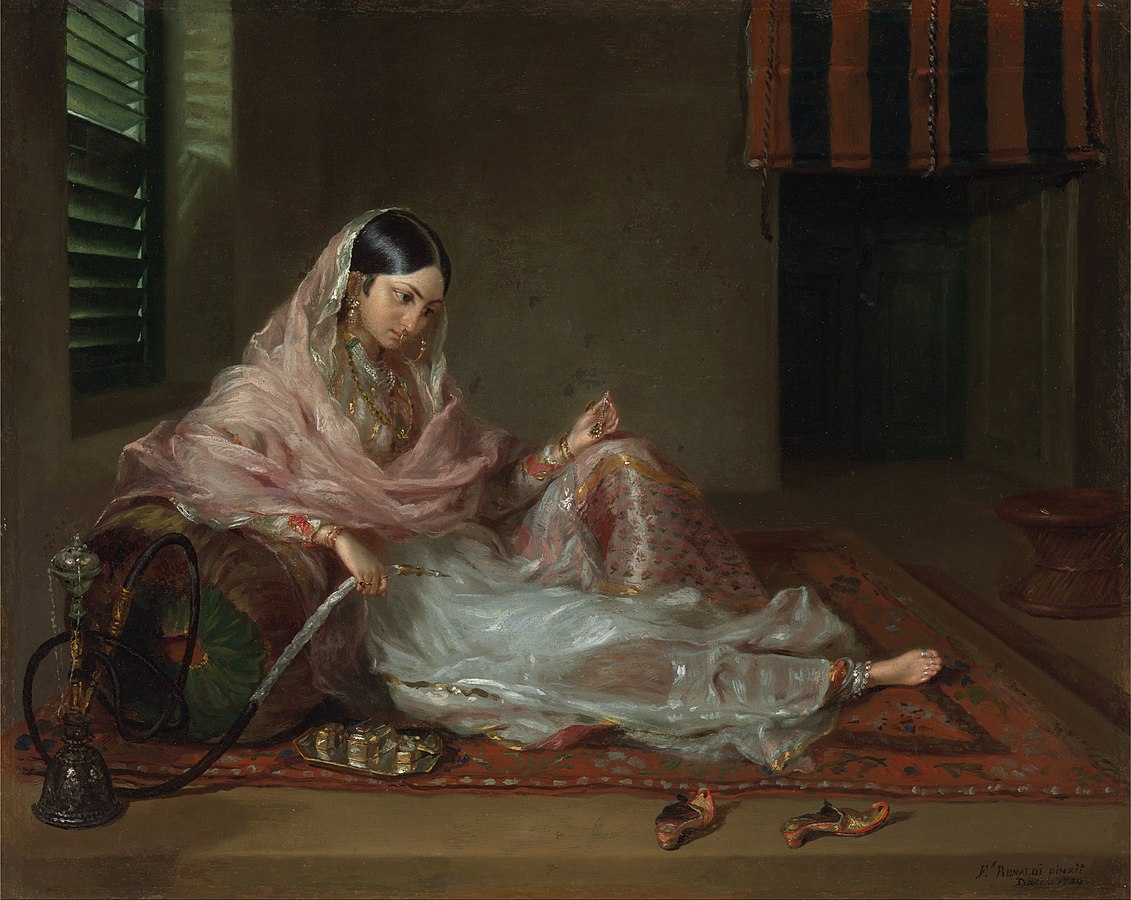
(Source-Wikimedia Commons, Women clad in fine Bengali muslin, painted by Francesco Renaldi in 1789)
Known as Jamdani, this original muslin was colored brightly while being lightweight. However, with the coming of European manufacturers, the industry was destroyed as factory-produced muslin flooded the markets. Even though Jamdani muslin became uneconomical due to punitive taxes, the listing of this fabric on the UNESCO Representative List of the Intangible Cultural Heritage of Humanity leads to more impetus for reviving the production of this once highly prized fabric as silk. The motifs found on a jamdani sari are geometric in shape and inspired by nature. The weavers count the threads to create these wonderful motifs on the fabric.
Next, Khadi is a handspun and handwoven cotton cloth that was popularised by Mahatma Gandhi and was turned into a symbol of economic self-sufficiency in the freedom struggle. Khadi cotton is light and breathable. Khadi silk is made by spinning silk or blending other yarns. There are in turn various kinds of khadi silk. One is Matka silk which is made from the waste of mulberry silk, sourced mainly from Karnataka and Kashmir. The other type is tussar silk which is mainly found in eastern parts of India. Khadi fabric is skin-friendly and durable. It is loose, lighter, and cooler which enhances ventilation, there by making it ideal summer wear. Donning khadi would define elegance simply and sustainably.

(Source- Textile Value Chain, Khadi Fabric)
Then, Kota Doria is another breathable fabric for summer. It involved the art of weaving cotton in a structured check pattern in an open weave. It is made from cotton and silk and it is perfect for summer wear due to the fabric’s sheerness and coded texture. The fabric is locally known as Kota Masuria, where the folklore suggests that the craft has its origins in Mysore hence the name. It was then shifted to Kota, Rajasthan where the weavers received patronage from the royal family. The use of synthetic as well as silk threads is woven with cotton threads which makes it cheaper and more durable. The main motifs are kairi or mango, leaves of different shapes, flowers, and geometrical patterns like stars, square arrangements, and circles.
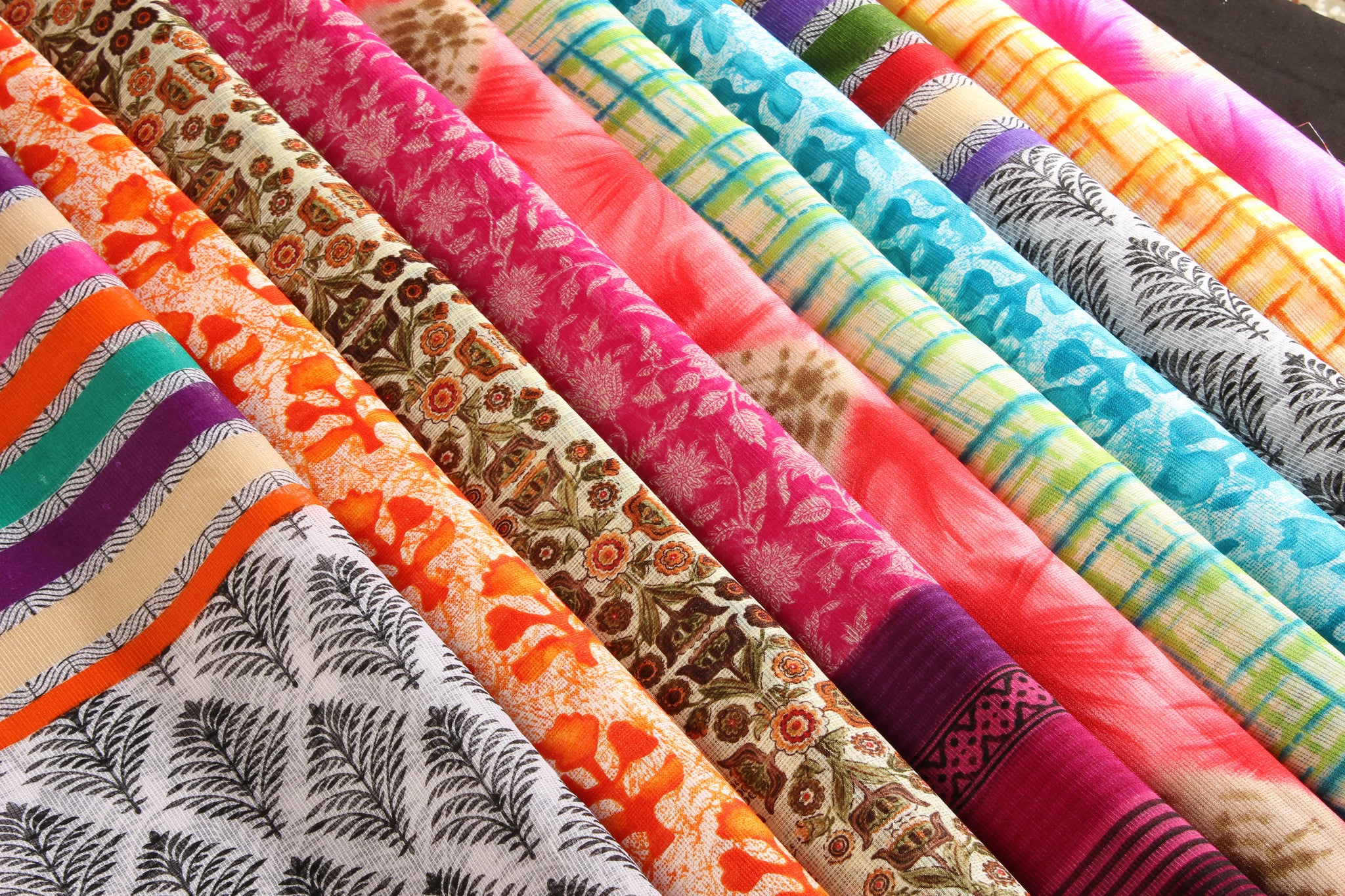
(Source- Fabriclore, Kota Doria)
Coming to another fabric, linen fabric was produced in India when The Jaya Shree Textiles was established in 1949, as India’s first facility for manufacturing linen. This fabric is long-lasting as well as highly moisture absorbent which makes it airy and breathable. Since its raw material is made from flax which is a natural insulator, linen clothing retains heat from the heat and lets go of the excess heat to provide comfortability. Handwoven linen has a distinct texture and the process is sustainable, unlike machine-made linen. This sustainability stems from the fact that flax is grown with minimal water requirements and no pesticides or herbicides in considerable quantities.
It is essential to adopt wearing this clothing in daily life that symbolizes artistic craftsmanship, sustainability, and fashion too!
SWITCHING TO TRADITIONAL INDIAN SUMMER CLOTHING
In this fast-paced world of increasing industrialization and globalization, one can easily fall prey to the trend of fast fashion, which prioritizes mass production and low prices. This exploitative business model compromises quality over quantity and leads to huge heaps of discarded garments. The industry caters to the needs and aspirations of customers seeking to keep up with the latest trends in the fashionista world. This model has cleverly overlooked environmental concerns and sustainability and has succeeded in wooing customers with their products.
But, customers need to pause and ponder for a moment the effectiveness and the durability of the product they are buying, in this rat race of constant purchases at low prices. They need to assess the longevity of the product they are buying and should attempt to make sustainable fashion choices. Customers need to also reflect upon themselves if they have done justice to the skills of the weavers by purchasing handwoven Indian fabrics. It is high time that people switch to eco-friendly Indian fashion, where fabrics are made from natural fibers. In the context of unbearable heat, people ought to wear these breathable textiles of cotton, muslin, or silk to support the weavers and their livelihood and to pay homage to our glorious textile heritage.
Switching to Indian fabrics in an era of fast fashion wouldn’t make someone less cool or fashionable. Donning these Indian fabrics proudly during summer or any other season shows concern for the environment and care for the weavers. In an increasingly interconnected world, one needs to wear local, buying these from local shops instead of big brands that are at times unethical. By modifying our dressing habits by shifting to local, hand-woven clothing, one thinks globally and about the worldwide repercussions that a single sustainable garment can have. Wearing such fabrics not only defines one’s respect towards the textile heritage of India but also seeks to define the eco-friendly nature of Indian fashion. These Indian textiles wouldn’t be cheaper than its power loom or machine-made equivalents. Indian textiles, interwoven by hand carry more value and reflect the intangible heritage of India. This value is reflected in the prices too.
Nowadays where e-commerce brings everything so quickly to one’s doorstep, environment-conscious customers need to step out and explore the local markets and shops, where they can buy these textiles or fabrics. Visiting a big brand in a shopping mall perhaps won’t bring the feel of the textile, that defines long years of exquisite craftsmanship and cultural legacy. Visiting a local shop would empower weavers and this renewed awareness about Indian fabrics would surely aid the economy as well. Moreover, the power of social media needs to be utilized to spread and create awareness of the benefits of wearing Indian fabrics during summer or throughout the year. Indian fabrics v/s fast fashion needs to be popularized to bring about learned and aware citizens of the country willing to make a change by shifting or switching towards sustainability by dressing traditional Indian handwoven textiles.
PLACES TO BUY- DONNING FABRICS WHILE EMPOWERING WEAVERS
While having the time to visit shopping malls, it becomes imperative to take some time and visit the local shops, to buy handwoven and handspun textiles of India. E-commerce websites also promote artisanal richness and cultural heritage while taking care of the environment.
The Ministry of Textiles, Government of India in 2015 launched the ‘India Handloom Brand’ on the occasion of the first National Handloom Day on August 7. This is an initiative for the branding of high-quality handloom products and seeks to earn the trust of customers by endorsing their quality in the design, processing, and embellishments. It further aims to bring high-quality handloom products in traditional as well as contemporary products with no harm to the environment. One can get more details regarding the retail stores and e-commerce platforms from where the handloom products can be bought on their official website.
Many e-commerce initiatives in India bring out the magnificent creations of the weavers and the artisans and motivate its customers to buy their products, thereby supporting and empowering the creators of wonderful handloom products.
One such initiative is GoSwadeshi which was launched by GoCoop in 2014. It is a movement for the promotion and celebration of Indian handlooms and crafts while empowering artisans, sustainability, and fair trade. They’ve empowered various craft communities across India by promoting their products and ensuring fair prices for the same. There are a variety of garments from which one can choose from.
Then, there is Anuprerna which works closely with 300 + weavers from Bengal and produces ethical fabrics and sustainable handwoven textiles utilizing the indigenous weaves and local Bengali techniques of weaving. They offer garments and scarves in fabrics such as cotton, linen, khadi, and also handloom silk fabrics. They seek to empower artisans and the rich textile culture. They aim to embrace the Gandhian ideals of self-reliance by creating community-supporting business like Anuprerna and also paying the artisans fair wages to help better their lives.
One can also buy silk and cotton textiles from Nalli, which has earned its name for exquisite silks. It stands as an iconic heritage brand, rooted in tradition. They trust and quality as traditions are passed down through time, thereby creating the right space for those who are appreciative of the warmth and richness of genuine craftsmanship. Their iconic status is due to their commitment to customer-centricity. Nalli stores are across major cities like Delhi, Mumbai, Ahmedabad, Kolkata, Hyderabad, and others and abroad too in the USA, Singapore, and Canada.
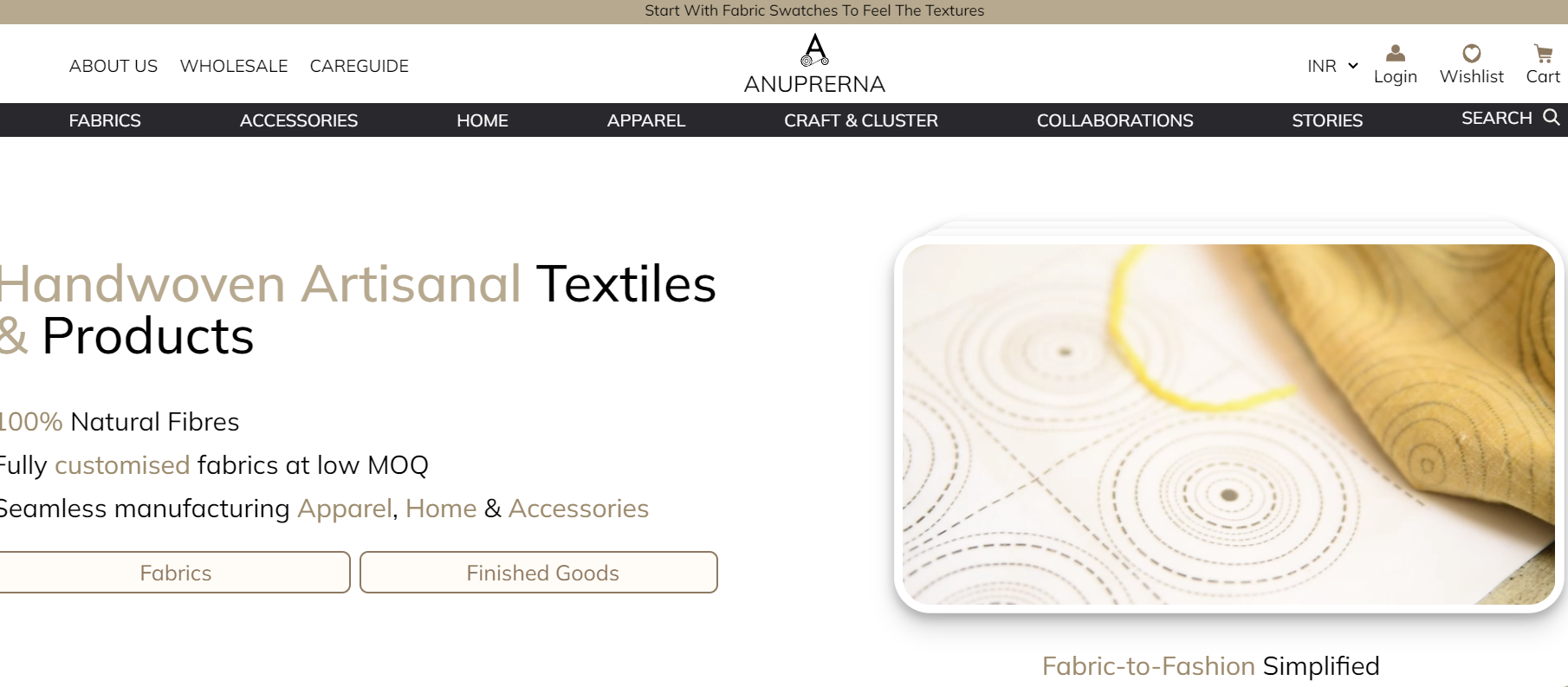
(Source, Anuprerna, A snapshot of the website where one can enjoy shopping for handwoven products)
It is always pleasurable to wear an Indian fabric summer wear that symbolizes ‘desi’ fashion which follows sustainability and empowerment of the artisanal community. It is not very challenging to adopt these in daily life when one starts to appreciate the skills of the weavers, thereby contributing to a wider acknowledgment of the cultural heritage of India. Donning native fabrics in an era of fast fashion becomes a style statement and if this gains ground in India, then new trends will follow shaping the contours of this fashion- a blend of sustainability concerns and paying ode to the rich textile legacy and heritage of the Indian subcontinent.
REFERENCES AND BIBLIOGRAPHY
https://indianculture.gov.in/timeless-trends/history-clothing-ancient-india
India Handloom Brand, Ministry of Textiles, Government of India
https://www.indiahandloombrand.gov.in/pages/know-your-products
https://www.indiahandloombrand.gov.in/vendorsite/view/home
https://www.nalli.com/about-us– Nalli
https://goswadeshi.in/pages/about-us-5– GoSwadeshi
https://blog.anuprerna.com/blog-details/about-the-brand/56485– Anuprerna
Gandhi S. (2019) Jamdani saris: History, evolution and how they are woven, Vogue India
https://www.vogue.in/content/jamdani-saree-history-origin-technique-indian-handloom
https://www.harappa.com/content/first-evidence-cotton-neolithic-mehrgarh-pakistan
https://www.plasticcollective.co/how-fast-fashion-is-bad-for-the-environment/
https://ruralhandmade.com/blog/looming-trouble-for-fast-fashion-why-handloom-is-coming
https://aanvay.com/our-value-chain/natural-pure-khadi
https://gaatha.org/Craft-of-India/kota-doria-kaithun-handloom/
https://writtenbyshweta.com/indian-fabrics/
https://twothirds.com/blogs/journal/7-extraordinary-facts-about-muslin-fabric
https://earth.org/fast-fashion-pollution-and-climate-change/
https://heritagemoda.com/en-in/blogs/blogs/everything-you-need-to-know-about-linen-fabric
https://fashinza.com/fabric/facts/khadi-fabric-everything-you-need-to-know/
https://amritmahotsav.nic.in/district-reopsitory-detail.htm?8941
https://www.bharatsthali.com/blogs/blog/about-indian-cotton-uses-and-benefits-of-cotton
IMAGE REFERENCES
https://textilevaluechain.in/in-depth-analysis/articles/basics-of-textiles/the-world-of-khadi
https://commons.wikimedia.org/wiki/File:Renaldis_muslin_woman.jpg
https://fabriclore.com/blogs/journal/the-ethereal-kota-doria
- Breathable fabrics for summer
- Breathable Indian fabrics
- Eco-friendly Indian fashion
- Handwoven Indian fabrics
- Indian cotton summer dresses
- Indian fabrics fast fashion
- Indian fabrics summer wear
- Indian fabrics vs fast fashion
- Indian textiles and sustainability
- Sustainable Indian fashion
- Sustainable summer clothing
- Traditional Indian summer clothing
- Traditional Indian textiles
